A Dynamic Risk Appraisal Model and Its Application in VTS Based on a Cellular Automata Simulation Prediction
Abstract
1. Introduction
2. Related Work
2.1. Dynamic Risk Management
- (1)
- Calculate and estimate the probabilities of individual ship collisions, groundings, and near-contact situations dynamically and gain a comprehensive understanding of ship traffic situations;
- (2)
- Estimate the consequences of possible accidents based on the characteristics of the vessel and the sea area;
- (3)
- Provide automatic warnings and guidance to VTS operators for risk assessments in real-time and at sea. VTS can be viewed as a decision-making process related to the implementation of maritime safety measures to mitigate risks. Therefore, VTS operators should provide optimal navigation advice and guidance to vessels in and out of the surrounding waters through VHF communications.
2.2. Track Prediction
- In points-based algorithms, the target maritime area is divided into different nonoverlapping two-dimensional cells. When given the current state of the ship, this type of algorithm determines the probability that the ship will occupy other nearby units after a given short time. The algorithms estimate the probability of the next state based on historical data (i.e., training set). This type of algorithm is usually used to predict the position of vessels on a small scale [26,27,28,29].
- Simulation-based algorithms are based on either cellular automata [33,34] or intelligent agents [35,36]. Each ship can be regarded as a definite particle, and the interaction between these particles is determined by the interaction of the vessels’ motions. Thus, the cellular automata approach appears to have a better renewal performance, which may be critical in many maritime contexts, especially in areas with high computational loads.
3. CA-Based Traffic Simulation
3.1. Fairway and Sensitive Area Modeling
3.2. Cellular Model
3.3. Updating Regulation
- (1)
- Free navigation: a current ship is the first ship or the distance between the current ship and the ship in front is greater than the safe distance, which is not affected by the driving status of the ship in front and maintains a constant speed according to its maximum speed. When the initial state is lower than the maximum speed, it accelerates to the maximum speed [39].
- (2)
- Following navigation: the following navigation includes an active and a passive following. Active following means that the current driving status can meet the demand of the ship driving, and the ship is willing to follow the ship ahead. Passive following means that the current driving cannot meet the demand (such as the speed of the forward ship is too slow, or does not meet the economic speed, etc.), overtaking safety conditions are also not satisfied (such as blocking in the opposite direction of the traffic lane, the distance between the current ship and the forward ship is too short, etc.), and the ship can only be forced to slow down to follow the forward ship and sail at the previous speed.
- (1)
- The safe distance range between the overtaking ship and the overtaken ship that is about to enter the front ship;
- (2)
- The speed of the rear ship is greater than that of the front ship;
- (3)
- No other ships are running in parallel.
4. Risk Weight and Appraisal
4.1. Appraisal Model
4.1.1. Expert Scoring Method Combined with the Cloud Model
4.1.2. Real-Time Traffic Risk Assessment Model
4.2. Experiments
4.2.1. Real-Time Traffic Flow Risk Evaluation Index
4.2.2. Real-Time Traffic Flow and Ship Risks in a Port
5. Conclusions
Author Contributions
Funding
Institutional Review Board Statement
Informed Consent Statement
Data Availability Statement
Conflicts of Interest
References
- International Association of Marine Aids to Navigation and Lighthouse Authorities (IALA). IALA Vessel Traffic Services Manual. 2021. Available online: https://indd.adobe.com/view/56fb7835-cee5-4423-9fff-724d2ea4b5c3 (accessed on 9 July 2021).
- Kharchenko, V.; Vasylyev, V. Decision-Making System for Vessel Traffic Planning and Radar Control. In Proceedings of the First European Radar Conference, Amsterdam, The Netherlands, 11–15 October 2004. [Google Scholar]
- Nuutinen, M.; Savioja, P.; Sonninen, S. Challenges of developing the complex socio-technical system: Realising the present, acknowledging the past, and envisaging the future of vessel traffic services. Appl. Ergon. 2006, 28, 513–524. [Google Scholar] [CrossRef]
- Lützhöft, M. “The technology is great when it works”: Maritime Technology and Human Integration on the Ship’s Bridge. Ph.D. Thesis, Linköping University, Linköping, Sweden, 2004. [Google Scholar]
- Aichhorn, K.; de Bedoya, C.C.; Berglez, P.; Cabeceira, M.L.; Troger, M.; Kemetinger, A. Maritime volumetric navigation system. In Proceedings of the 25th International Technical Meeting of the Satellite Division of the Institute of Navigation, Nashville, TN, USA, 17–21 September 2012; pp. 3651–3657. [Google Scholar]
- Mallam, S.C.; Lundh, M. The physical work environment and end-user requirements: Investigating marine engineering officers’ operational demands and ship design. Work 2016, 54, 989–1000. [Google Scholar] [CrossRef]
- Van de Merwe, F.; Kähler, N.; Securius, P. Crew-centred Design of Ships—The CyClaDes project. Transp. Res. Procedia 2016, 14, 1611–1620. [Google Scholar] [CrossRef][Green Version]
- Costa, N.A.; Lundh, M.; MacKinnon, S.N. Identifying Gaps, Opportunities and User Needs for Future E-Navigation Technology and Information Exchange; Springer International Publishing: Cham, Switzerland, 2018. [Google Scholar]
- Costa, N.A.; Lundh, M.; MacKinnon, S.N. Non-technical communication factors at the vessel traffic services. Cogn. Technol. Work 2018, 20, 63–72. [Google Scholar] [CrossRef]
- Man, Y.; Lützhöft, M.; Costa, N.A.; Lundh, M.; MacKinnon, S.N. Gaps Between Users and Designers: A Usability Study About a Tablet-Based Application Used on Ship Bridges. In Proceedings of the International Conference on Applied Human Factors and Ergonomics, Los Angeles, CA, USA, 17–21 July 2017; Springer: Cham, Switzerland, 2017. [Google Scholar]
- Praetorius, G.; Lützhöft, M. Decision support for vessel traffic service (VTS): User needs for dynamic risk management in the VTS. Work 2012, 41, 4866–4872. [Google Scholar] [CrossRef] [PubMed]
- Rausand, M. Chapter 1: Introduction. In Risk Assessment: Theory, Methods, and Applications; John Wiley & Sons: Hoboken, NJ, USA, 2013; pp. 1–28. [Google Scholar]
- Baldauf, M.; Wiersma, E. Risk Recognition and Collision Avoidance by VTS Operators. IFAC Proc. 1998, 31, 239–244. [Google Scholar] [CrossRef]
- Mehdi, R.; Baldauf, M.; Deeb, H. A dynamic risk assessment method to address safety of navigation concerns around offshore renewable energy installations. J. Eng. Marit. Environ. 2019, 234, 231–244. [Google Scholar] [CrossRef]
- Relling, T.; Lützhöft, M.; Hildre, H.P.; Ostnes, R. How vessel traffic service operators cope with complexity—Only human performance absorbs human performance. Theor. Issues Ergon. Sci. 2019, 21, 418–441. [Google Scholar] [CrossRef]
- Van Westrenen, F.C. The Maritime Pilot at Work: Evaluation and Use of a Time-to-Boundary Model of Mental Workload in Human–Machine Systems. Ph.D. Thesis, Delft University of Technology, Delft, The Netherlands, 1999. [Google Scholar]
- Robert, G.; Hockey, J.; Healey, A.; Crawshaw, M.; Wastell, D.G.; Sauer, J. Cognitive demands of collision avoidance in simulated ship control. Hum. Factors 2003, 45, 252–265. [Google Scholar] [CrossRef]
- Van Westrenen, F.; Ellerbroek, J. The effect of traffic complexity on the development of near misses on the North Sea. IEEE Trans. Syst. Man Cybern. Syst. 2015, 47, 432–440. [Google Scholar] [CrossRef]
- Van Westrenen, F.; Praetorius, G. Maritime traffic management: A need for central coordination? Cogn. Technol. Work 2014, 16, 59–70. [Google Scholar] [CrossRef]
- Van Westrenen, F.; Baldauf, M. Improving conflicts detection in maritime traffic: Case studies on the effect of traffic complexity on ship collisions. J. Eng. Marit. Environ. 2020, 234, 209–222. [Google Scholar] [CrossRef]
- Relling, T.; Praetorius, G.; Hareide, O.S. A socio-technical perspective on the future Vessel Traffic Services. Necesse 2019, 4, 112–129. [Google Scholar] [CrossRef]
- Aylward, K.; Johannesson, A.; Weber, R.; MacKinnon, S.N.; Lundh, M. An evaluation of low-level automation navigation functions upon vessel traffic services work practices. WMU J. Marit. Aff. 2020, 19, 313–335. [Google Scholar] [CrossRef]
- Hueffmeier, J.; Berglund, R.; Porthin, M.; Rosqvist, T.; Silvonen, P.; Timonen, M.; Lindberg, U. Dynamic Risk Analysis Tools/Models; SSPA Sweden AB: Gothenburg, Sweden, 2012. [Google Scholar]
- Hüffmeier, J.; Wilske, E.; Grundevik, P. BaSSy—Decision Support Tool for VTS Operators; SSPA Sweden AB: Gothenburg, Sweden, 2009. [Google Scholar]
- Virjonen, P.; Nevalainen, P.; Pahikkala, T.; Heikkonen, J. Ship Movement Prediction Using k-NN Method. In Proceedings of the 2018 Baltic Geodetic Congress (BGC Geomatics), Olsztyn, Poland, 21–23 June 2018; pp. 304–309. [Google Scholar]
- Cazzanti, L.; Pallotta, G. Mining maritime vessel traffic: Promises, challenges, techniques. In Proceedings of the OCEANS 2015-Genova, Genova, Italy, 18–21 May 2015; pp. 1–6. [Google Scholar]
- BRhodes, B.J.; Bomberger, N.A.; Zandipour, M. Probabilistic associative learning of vessel motion patterns at multiple spatial scales for maritimesituation awareness. In Proceedings of the 2007 10th International Conference on Information Fusion, Quebec, QC, Canada, 9–12 July 2007; p. 18. [Google Scholar]
- Deng, F.; Guo, S.; Deng, Y.; Chu, H.; Zhu, Q.; Sun, F. Vessel track information mining using AIS data. In Proceedings of the 2014 International Conference on Multisensor Fusion and Information Integration for Intelligent Systems (MFI), Beijing, China, 28–19 September 2014; p. 16. [Google Scholar]
- Ristic, B. Detecting anomalies from a multitarget tracking output. IEEE Trans. Aerosp. Electron. Syst. 2014, 50, 798–803. [Google Scholar] [CrossRef]
- Perera, L.P.; Oliveira, P.; Soares, C.G. Maritime traffic monitoring based on vessel detection, tracking, state estimation, and trajectory prediction. IEEE Trans. Intell. Transp. Syst. 2012, 13, 1188–1200. [Google Scholar] [CrossRef]
- De Vries, G.K.D.; Van Someren, M. Machine learning for vessel trajectories using compression, alignments and domain knowledge. Expert Syst. Appl. 2012, 39, 13426–13439. [Google Scholar] [CrossRef]
- Pallotta, G.; Vespe, M.; Bryan, K. Vessel pattern knowledge discovery from ais data: A framework for anomaly detection and route prediction. Entropy 2013, 15, 2218–2245. [Google Scholar] [CrossRef]
- Feng, H. Cellular Automaton Ship Traffic Flow Model Considering Integrated Bridge System. Int. J. u- e- Serv. Sci. Technol. 2013, 6, 111–120. [Google Scholar]
- Blokus-Roszkowska, A.; Smolarek, L. Application of simulation methods for evaluating the sea waterways traffic organization. ISRN Appl. Math. 2013, 7, 1–9. [Google Scholar] [CrossRef]
- Numano, M.; Itoh, H.; Niwa, Y. Sea traffic simulation and its visualization in multi-pc system. In Proceedings of the International Congress on Modeling and Simulation, Canberra, Australia, 10–13 December 2001; pp. 2093–2098. [Google Scholar]
- Xiao, F.; Ligteringen, H.; Gulijk, C.V.; Ale, B. Nautical traffic simulation with multi-agent system for safety. In Proceedings of the 16th International IEEE Conference on Intelligent Transportation Systems (ITSC 2013), The Hague, Netherlands, 6–9 October 2013. [Google Scholar]
- Convention on the International Regulations for Preventing Collisions at Sea. Available online: http://www.admiraltylawguide.com/conven/collisions1972.html (accessed on 11 May 2021).
- Fujii, Y.; Tanaka, K. Traffc capacity. J. Navig. 1971, 24, 543–552. [Google Scholar] [CrossRef]
- Wu, Z.; Wang, X.-J. Study of Vessel Traffic Flow in Inland Waterway. J. Guizhou Univ. (Nat. Sci.) 2014, 31, 118–122. [Google Scholar]
- Tian, L.; Zhang, Y.; Li, N. Research on real-time warning index system of water traffic safety along the Yangtze river trunk line. Traffic Inf. Saf. 2013, 31, 69–73, 78. [Google Scholar]
- International Association of Marine Aids to Navigation and Lighthouse Authorities. IALA Guideline – G1124. The use of Ports and Waterways Safety Assessment (PAWSA) MK II tool. 20 June 2017. Available online: https://www.iala-aism.org/product/g1124-use-ports-waterways-safety-assessment-pawsa-mkii-tool/ (accessed on 9 July 2021).
- Dalkey, N.; Helmer, O. An Experimental Application of the Delphi Method to the use of experts. Manag. Sci. 1963, 9, 458–467. [Google Scholar] [CrossRef]
- Li, D.; Liu, C. On the universality of the normal cloud model. China Eng. Sci. 2004, 8, 28–34. [Google Scholar]
- Zhang, L.; Wu, X.; Chen, Q.; Skibniewski, M.J.; Zhong, J. Developing a cloud model based risk assessment methodology for tunnel-induced damage to existing pipelines. Stoch. Environ. Res. Risk Assess. 2015, 29, 513–526. [Google Scholar] [CrossRef]
- Zhang, L.; Wu, X.; Ding, L.; Skibniewski, M.J. A novel model for risk assessment of adjacent buildings in tunneling environments. Build. Environ. 2013, 65, 185–194. [Google Scholar] [CrossRef]
- Chen, J.F.; Zhao, S.F.; Shao, Q.X.; Wang, H.M. Risk Assessment on Drought Disaster in China Based on Integrative Cloud Model. Res. J. Appl. Sci. Eng. Technol. 2012, 4, 1137–1146. [Google Scholar]
- Sur, J.M.; Kim, D.J. Comprehensive risk estimation of maritime accident using fuzzy evaluation method—Focusing on fishing vessel accident in Korean waters. Asian J. Shipp. Logist. 2020, 36, 127–135. [Google Scholar] [CrossRef]
- He, J.; Wang, L.; Xu, S. Enterprise Quality Performance Evaluation based on cloud Model. Stat. Decis. -Mak. 2018, 34, 172–175. [Google Scholar]
- Xi, J.; Yang, J. Study on Wuhan inland waters ship navigation safety risk assessment based on the cloud model. In Proceedings of the 2015 International Conference on Transportation Information and Safety (ICTIS), Wuhan, China, 25–28 June 2015. [Google Scholar]
- Xu, Z.-J.; Zhang, Y.-P.; & Su, H.-S. Application of risk assessment on fuzzy comprehensive evaluation method based on the cloud model. J. Saf. Environ. 2014, 14, 69–72. [Google Scholar]
- Li, C.L. Uncertain Knowledge Representation Based on Cloud Model. Comput. Eng. Appl. 2004, 40, 32–35. [Google Scholar]
- Zhu, J.; Lan, P.; Xu, S. Comprehensive evaluation method for port navigation safety. China Marit. Navig. 2015, 38, 79–82. [Google Scholar]

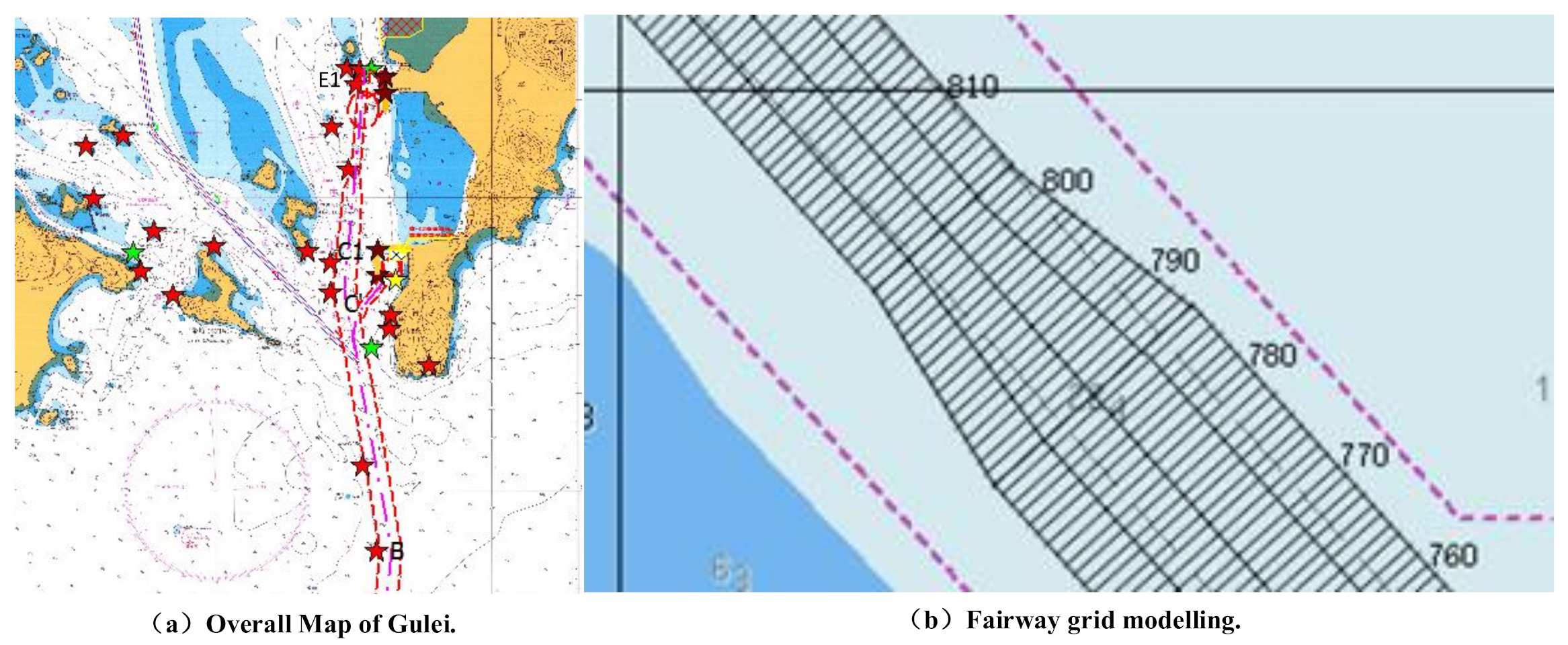
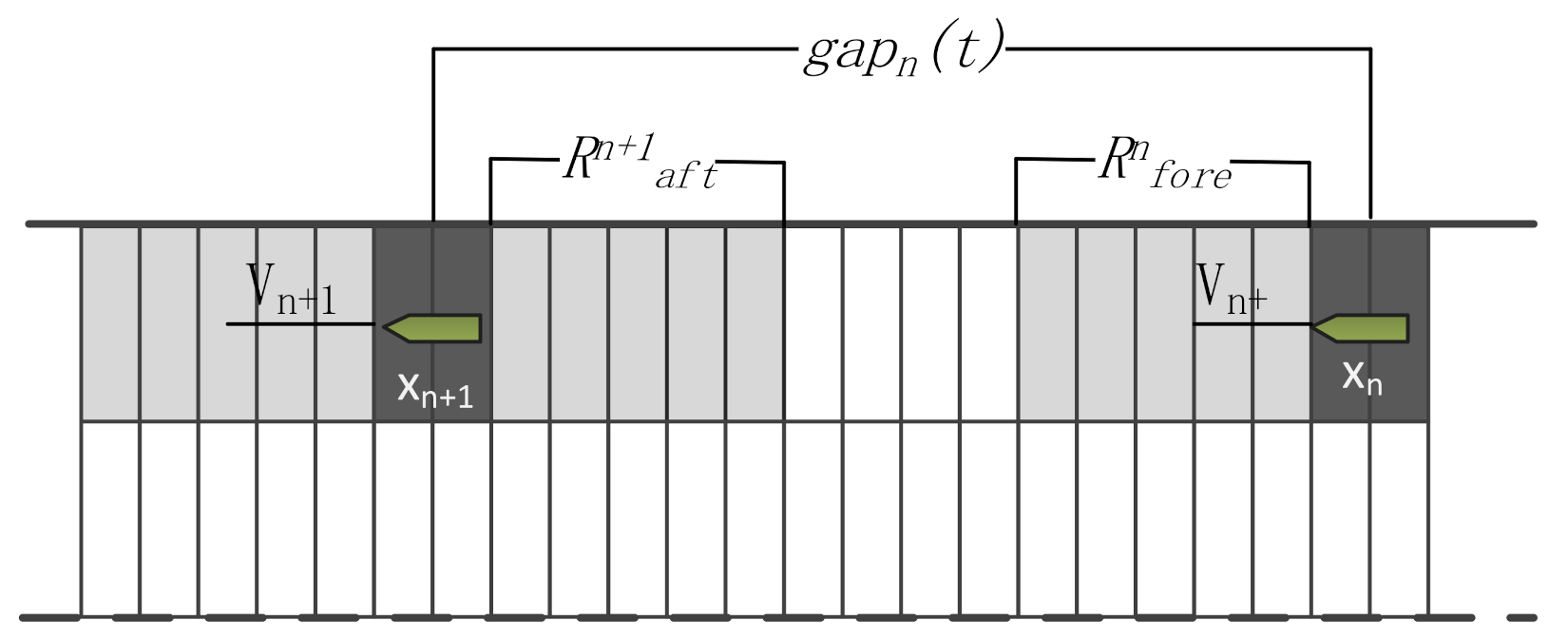
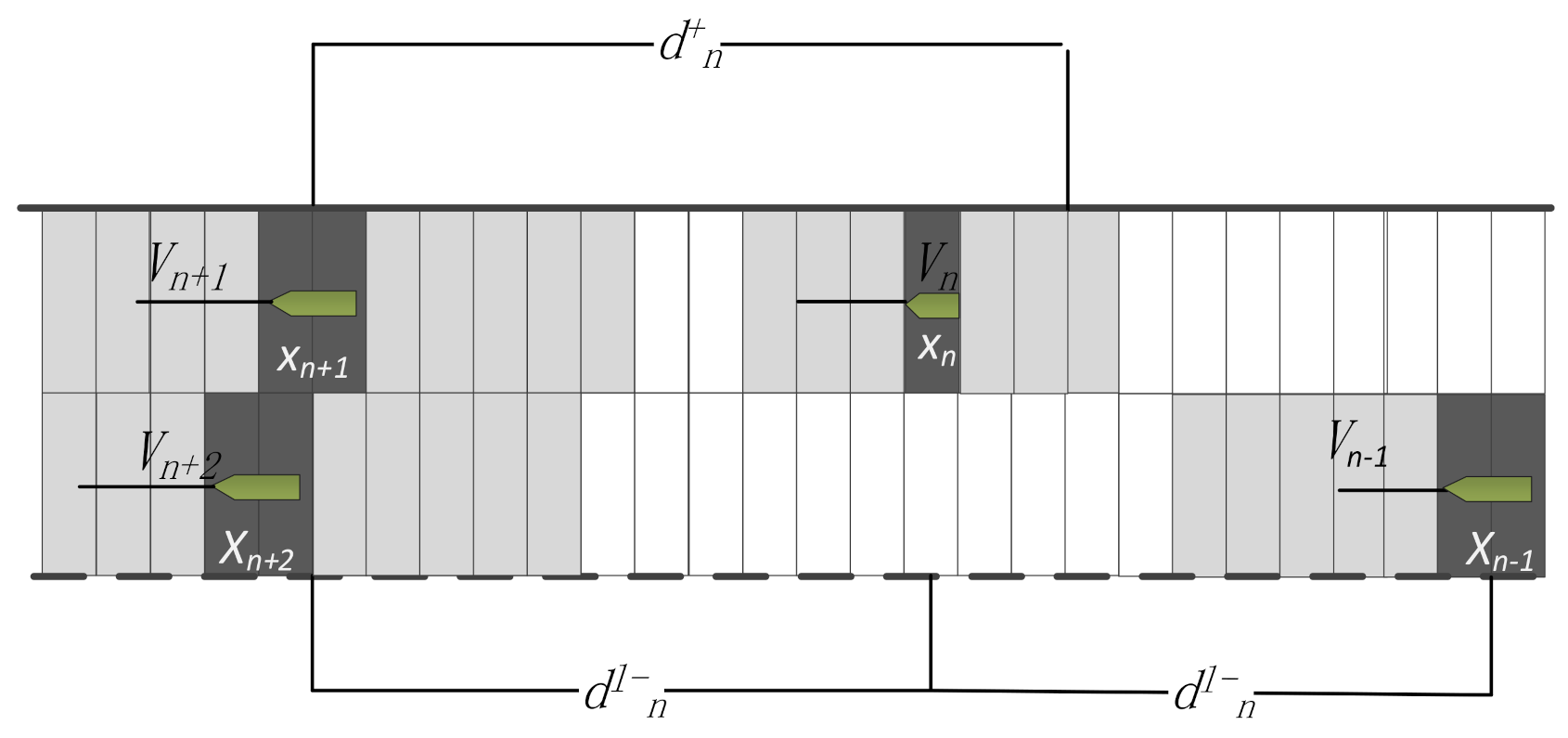

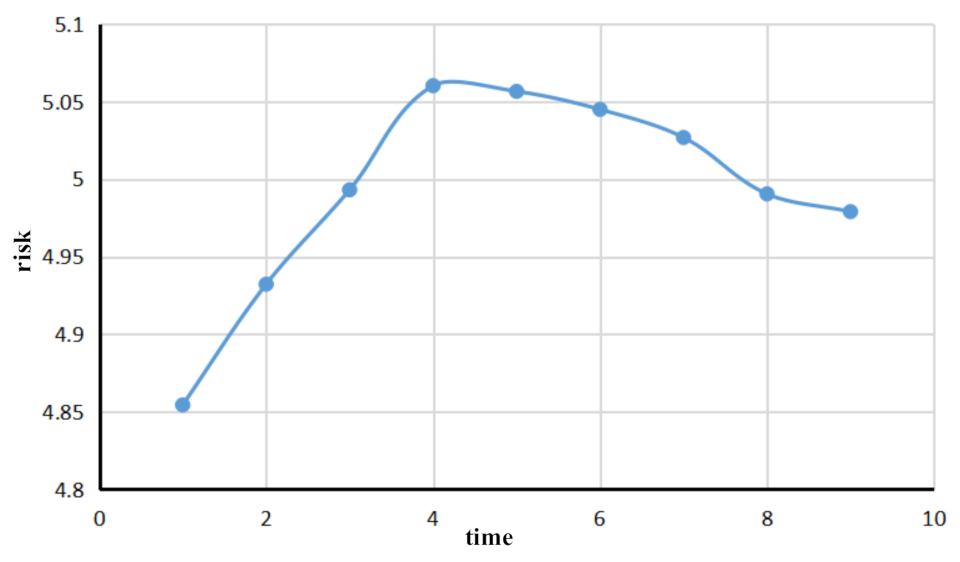

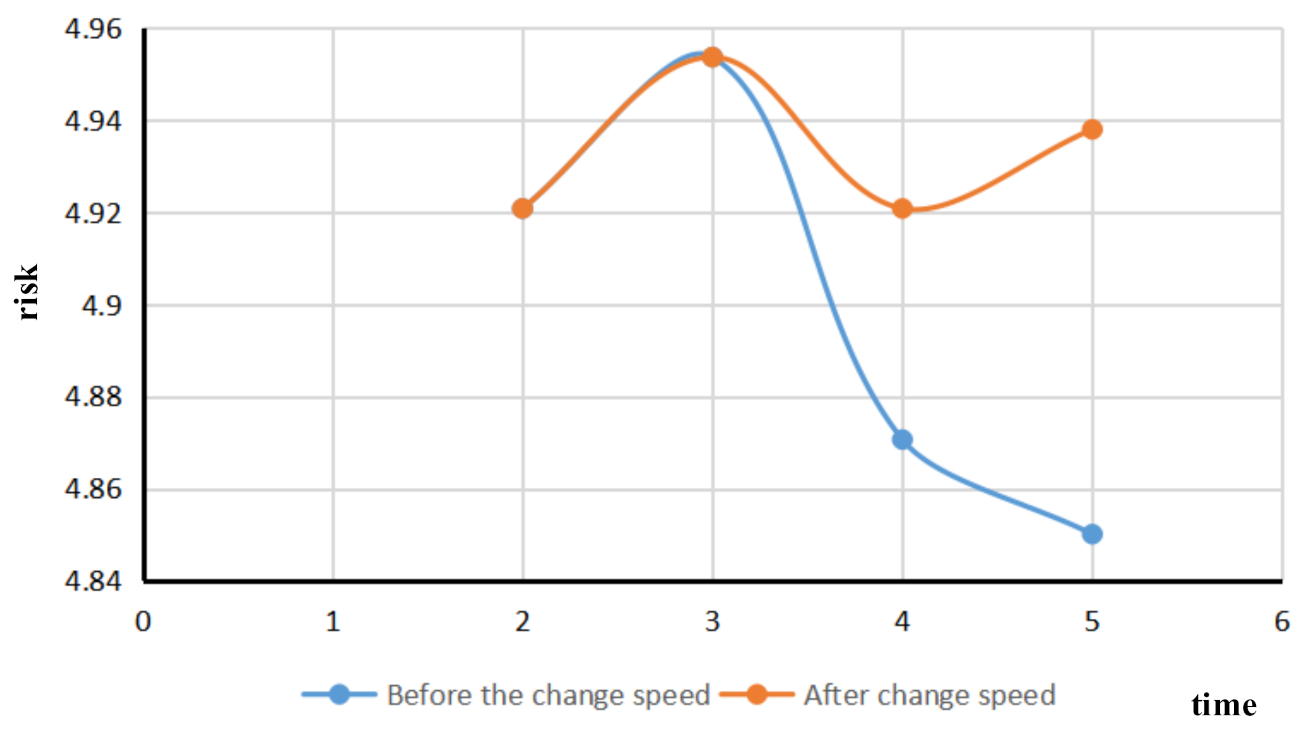

| Each Sub-Item of the First-Level Index | Sub-Items of Secondary Indicators | Each Sub-Item of the Three-Level Index |
|---|---|---|
| The crew factors 0.387 | Length of service 0.565 | |
| History of demerit points 0.435 | ||
| Ship factors | Type of ship 0.221 | |
| 0.286 | Ship Condition 0.265 | Age of ship 0.484 |
| PSC 0.516 | ||
| Ship Condition 0.25 | Ship length 0.359 | |
| Length to width ratio 0.272 | ||
| Ship draft 0.37 | ||
| Ship speed 0.265 | ||
| Environmental factors | Hydrologic Weather 0.343 | leeway and drift angle 0.494 |
| 0.328 | Visibility 0.506 | |
| Encounter situation 0.269 | Overtaking count 0.313 | |
| Crossover count 0.385 | ||
| Encounter count 0.302 | ||
| Encounter water 0.389 | Anchorage access count 0.226 | |
| Shallow water and rocks count 0.298 | ||
| Track Convergence count 0.298 | ||
| Ordinary waters 0.177 |
Publisher’s Note: MDPI stays neutral with regard to jurisdictional claims in published maps and institutional affiliations. |
© 2021 by the authors. Licensee MDPI, Basel, Switzerland. This article is an open access article distributed under the terms and conditions of the Creative Commons Attribution (CC BY) license (https://creativecommons.org/licenses/by/4.0/).
Share and Cite
Suo, Y.; Sun, Z.; Claramunt, C.; Yang, S.; Zhang, Z. A Dynamic Risk Appraisal Model and Its Application in VTS Based on a Cellular Automata Simulation Prediction. Sensors 2021, 21, 4741. https://doi.org/10.3390/s21144741
Suo Y, Sun Z, Claramunt C, Yang S, Zhang Z. A Dynamic Risk Appraisal Model and Its Application in VTS Based on a Cellular Automata Simulation Prediction. Sensors. 2021; 21(14):4741. https://doi.org/10.3390/s21144741
Chicago/Turabian StyleSuo, Yongfeng, Zhihong Sun, Christophe Claramunt, Shenhua Yang, and Zhibing Zhang. 2021. "A Dynamic Risk Appraisal Model and Its Application in VTS Based on a Cellular Automata Simulation Prediction" Sensors 21, no. 14: 4741. https://doi.org/10.3390/s21144741
APA StyleSuo, Y., Sun, Z., Claramunt, C., Yang, S., & Zhang, Z. (2021). A Dynamic Risk Appraisal Model and Its Application in VTS Based on a Cellular Automata Simulation Prediction. Sensors, 21(14), 4741. https://doi.org/10.3390/s21144741







